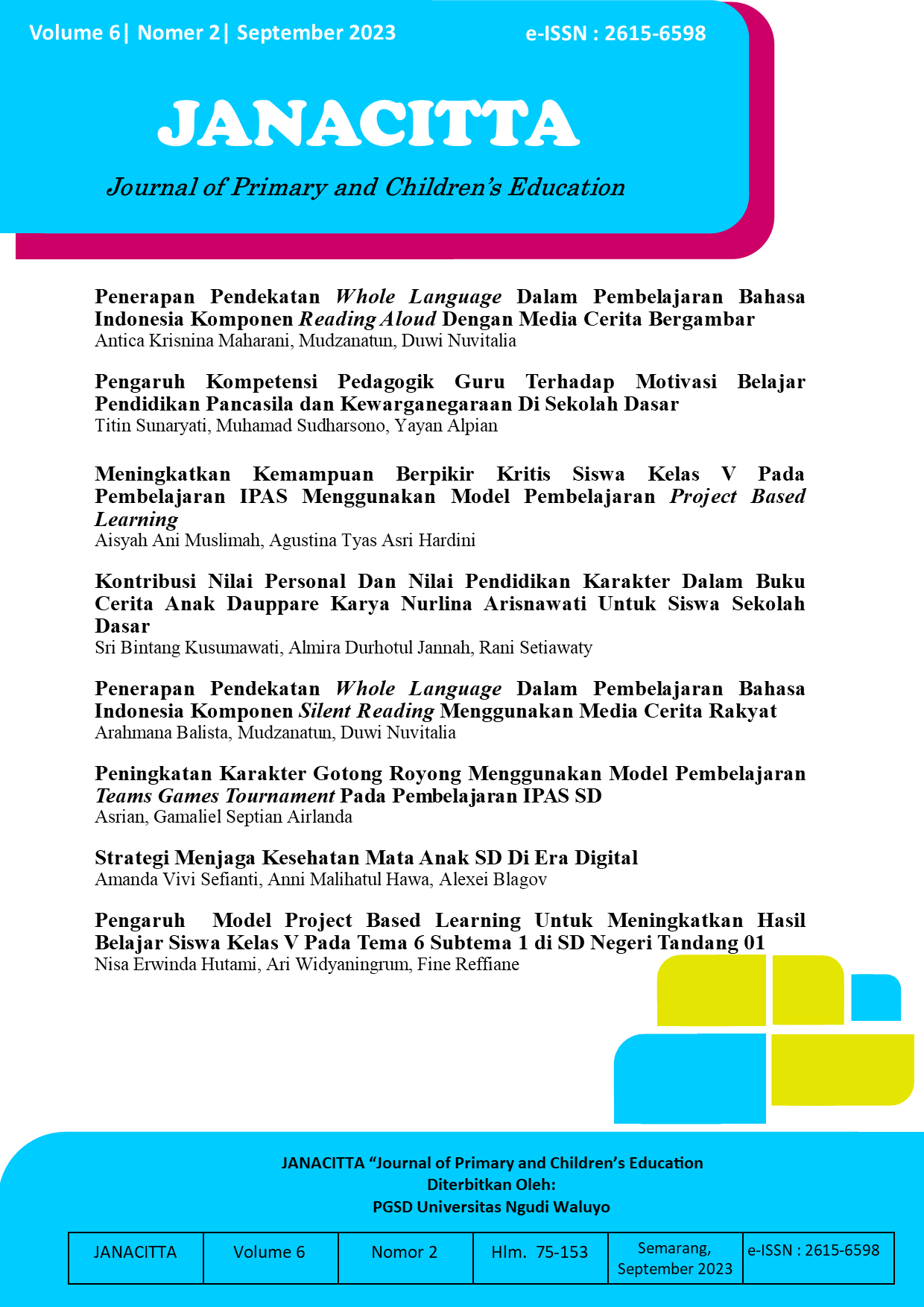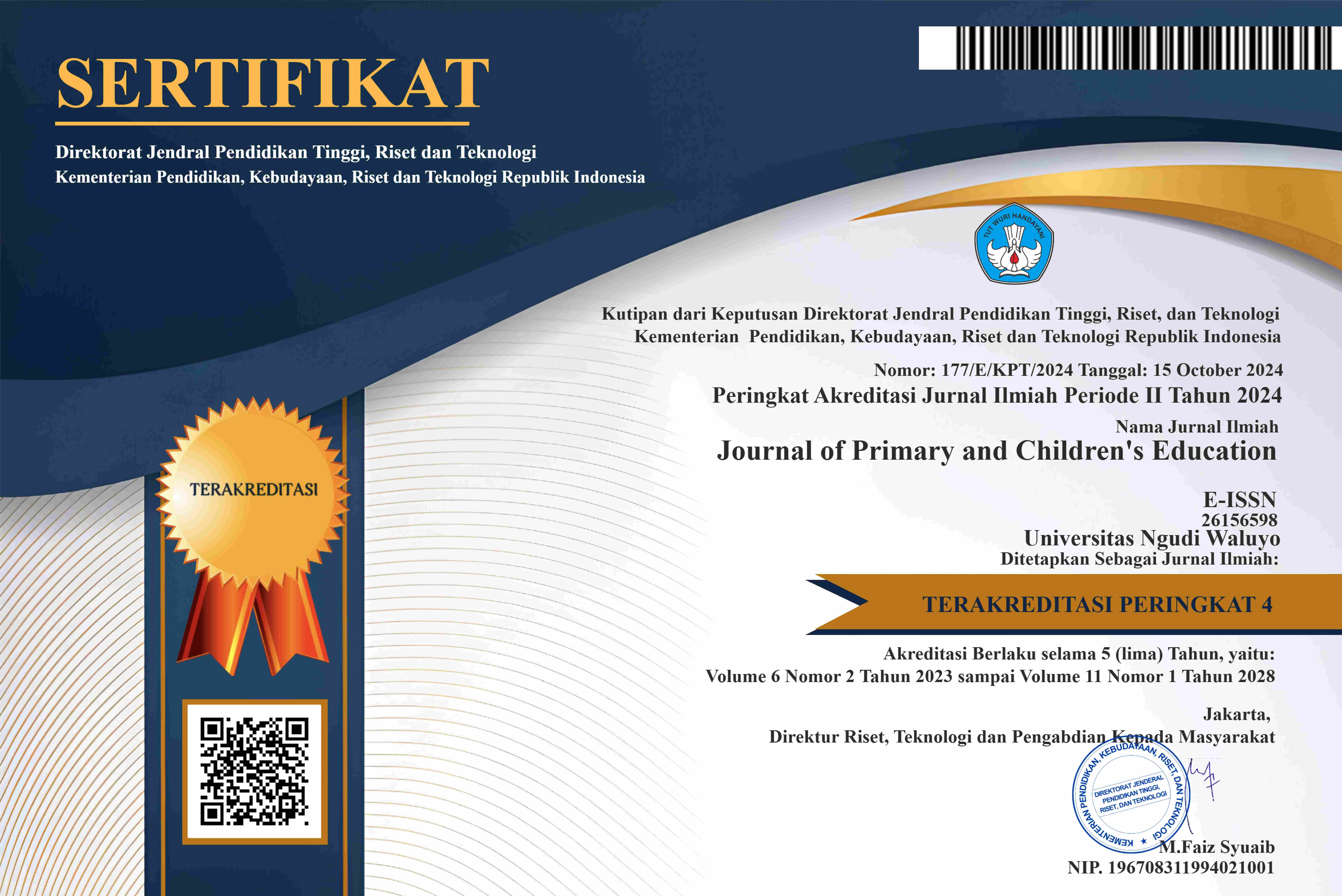Penerapan Pendekatan Whole Language Dalam Pembelajaran Bahasa Indonesia Komponen Silent Reading Menggunakan Media Cerita Rakyat
DOI:
https://doi.org/10.35473/jnctt.v6i2.2615Abstract
Abstract
The background that prompted this research was that almost all students in the high grades were able to read well so very few students experienced reading difficulties. However, there are still few students who are able to understand the text they read. In addition, learning has been carried out online in recent years which has resulted in students having low interest in reading. The objectives to be achieved in this study are to 1) Know the application of the whole language approach in teaching Indonesian the silent reading component in class V SDN 01 Protomulyo. 2) Knowing students' reading comprehension skills in understanding the contents of the text read. This type of research is descriptive qualitative with processing and data collection in accordance with the facts in the field. Data obtained from interviews, observations, tests and documentation. The data obtained were analyzed and presented in a descriptive form. The subjects of this study were fifth grade students at SDN 01 Protomulyo. The results of the study showed that fifth grade students were good at reading, it's just that their understanding of reading was still lacking. It was proven that at the first meeting before the whole language approach was implemented in class, the students' test results were still far from expectations. And the average at the time of the first meeting is also still low. In contrast to the second and third meetings, the average has experienced a good increase. At the first meeting, the average score in class V was 58. The second meeting, the average increased to 69. Finally, at the third meeting, the average increased to 80.
Abstrak
Latar belakang yang mendorong penelitian ini adalah hampir seluruh siswa yang ada di kelas tinggi sudah mampu membaca dengan baik sehingga sangat minim siswa yang mengalami kesulitan dalam membaca. Namun, masih sedikit siswa yang mampu memahami teks yang ia baca. Ditambah lagi pembelajaran dilakukan secara daring beberapa tahun terakhir yang mengakibatkan siswa memiliki minat baca yang rendah. Tujuan yang hendak dicapai dalam penelitian ini adalah untuk 1) Mengetahui penerapan pendekatan whole language dalam pembelajaran bahasa Indonesia komponen silent reading di kelas V SDN 01 Protomulyo. 2) Mengetahui kemampuan membaca pemahaman siswa dalam memahami isi teks yang dibaca. Jenis penelitian ini adalah deskriptif kualitatif dengan pengolahan dan pengambilan data sesuai dengan fakta di lapangan. Data diperoleh dari hasil wawancara, observasi, tes dan dokumentasi. Data yang diperoleh dianalisis dan disajikan dalam bentuk deskriptif. Subjek penelitian ini adalah siswa kelas V SDN 01 Protomulyo. Hasil penelitian menunjukkan bahwa siswa kelas V sudah baik dalam membaca, hanya saja pemahaman mereka dalam membaca masih dikatakan kurang. Terbukti pada pertemuan pertama sebelum diterapkan pendekatan whole language di kelas hasil tes siswa masih jauh dari harapan. Serta rata-rata pada saat pertemuan pertama juga masih rendah. Berbeda dengan pada saat pertemuan kedua dan ketiga rata-rata sudah mengalami peningkatan yang sudah baik. Pada pertemuan pertama rata-rata nilai di kelas V adalah 58. Pertemuan kedua rata-rata naik menjadi 69. Terakhir pada pertemuan ketiga rata-rata mengalami kenaikan menjadi 80.
References
Aisyah, S., Yarmi, G., Sumantri, M. S., & Iasha, V. (2020). Kemampuan Membaca Permulaan Melalui Pendekatan Whole Language di Sekolah Dasar. Jurnal Basicedu, 4(3), 637–643. https://doi.org/10.31004/basicedu.v4i3.393
Ambarita, R. S., Wulan, N. S., & Wahyudin, D. (2021). Analisis Kemampuan Membaca Pemahaman pada Siswa Sekolah Dasar. Edukatif : Jurnal Ilmu Pendidikan, 3(5), 2336–2344. https://edukatif.org/index.php/edukatif/article/view/836
Anggraeni, N. D. (2019). Pendampingan Belajar Bahasa Indonesia Melalui Pendekatan Whole Language Di Sekolah Dasar Negeri 020 Galang. Minda Baharu, 3(2), 145. https://doi.org/10.33373/jmb.v3i2.2120
Dr. Muhammad Ramdhan S.Pd., M. . (2021). Metode Penelitian (A. A. Effendy (ed.)).
Fitri, A. W., & Ummah, L. (2022). Pengaruh Pendekatan Whole Language Terhadap Kemampuan Membaca Permulaan Pada Anak Usia 5-6 Tahun. Aulad: Journal on Early Childhood, 5(1), 111–116. https://doi.org/10.31004/aulad.v5i1.276
Fitriani, L., & Nurjamaludin, M. (2020). Efektivitas Model Cooperative Integrated Reading and Composition (Circ) Untuk Meningkatkan Kemampuan Membaca Pemahaman Cerita Fiksi. Bale Aksara, 1(1), 31–42. https://doi.org/10.31980/ba.v1i1.737
Gunarwati, R., Maula, L. H., & Nurasiah, I. (2021). Analisis Kemampuan Membaca Pemahaman Berbasis Daring Pada Siswa Sekolah Dasar. 4(September). http://jurnal.unw.ac.id/index.php/janacitta
Lestari, A., & Suryani, E. (2022). Pengaruh Model Pembelajaran Picture And Picture Berbantuan Flash Card Terhadap Pemahaman Konsep Rantai Makanan Pada Siswa Kelas V Sdn 2 Sukorejo. 5(024), 55–61.
Nurjanah, R., Widiawati, U., & Suardana, I. M. (2020). Big Book dan Sustained Silent Reading untuk Meningkatkan Kemampuan Membaca Pemahaman. Jurnal Pendidikan: Teori, Penelitian, Dan Pengembangan, 5(7), 920. https://doi.org/10.17977/jptpp.v5i7.13716
Purwanti, K. Y., Putra, L. V., Studi, P., Guru, P., & Dasar, S. (2019). Keefektifan Circ Melalui Video Animasi Terhadap Kemampuan Membaca Pemahaman Dengan Motivasi Sebagai Variabel Moderating. http://jurnal.unw.ac.id/index.php/janacitta
Rismawati, D. (2016). Dyan Rismawati_12103241058.
Rohartati, S. (2018). Meningkatkan Keterampilan Membaca Pemahaman Peserta Didik Sekolah Dasar Melalui Pendekatan Whole Language. November, 6–7.
Syina, D. H. (2021). Penerapan Metode Pembelajaran Reading Aloud dengan Media Cergam (Cerita Bergambar) Untuk meningkatkan Hasil Belajar Tema 3 Sub Tema 4 “Kegiatan Malam Hari” Siswa Kelas I SD Negeri Muktiharjo Lor. 3(March), 6.
Viora, D., Wahyuningsi, E., Surya, Y. F., & Marta, R. (2021). Penerapan Pendekatan Whole Language dalam Pembelajaran Bahasa Indonesia di Sekolah Dasar. Pendidikan Tambusai, 5, 9379–9386.
Downloads
Published
How to Cite
Issue
Section
License
Copyright notice:
- Authors retain copyright and grant the journal right of first publication with the work simultaneously licensed under Creative Commons Attribution License that allows others to share the work with an acknowledgement of the work's authorship and initial publication in this journal.
- Authors are able to enter into separate, additional contractual arrangements for the non-exclusive distribution of the journal's published version of the work (e.g., post it to an institutional repository or publish it in a book), with an acknowledgement of its initial publication in this journal.
- Authors are permitted and encouraged to post their work online (e.g., in institutional repositories or on their website) prior to and during the submission process, as it can lead to productive exchanges, as well as earlier and greater citation of published work (The Effect of Open Access)







